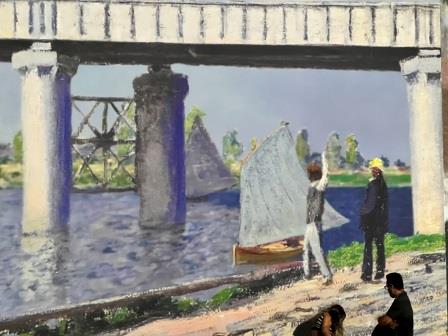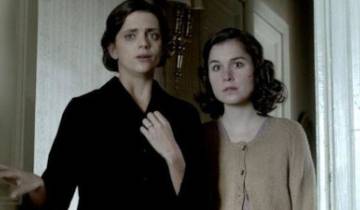
Exhibition "Monet À Beira D'Água"
Date: March 19 to June 12, 2022
Location: Rio de Janeiro Olympic Boulevard
Address: Av. Venezuela, 194 - Rio de Janeiro
“Monet à beira d´água” is an immersive exhibition. Follow, from the new technologies, the intentions of the artist: to submerge the visitor's eye in the illusion of the landscape without margin and painting without molding. Inside the black box of the exhibition space, illuminated by projection work, the observer can immerse in an environment covered by fluctuating images, walk on the waters or find the last rays of the sun.
This exhibition space was planned as a relay. On one side, its drainage continues to form the lake of Giverny. On the other, it is inspired by the scale of landscapes to raise structures in various formats (flat, concave and spherical) in order to support the projected images. From two works of digital manipulation, Monet's paintings, a coup de ilusão, creates liquid walls, fluctuating floors and an open ceiling for the celestial revolutions.
I can smell a lake, in “Monet à beira d´água”, in the image of a flood. As soon as the landscape passes as living water, the exhibition appears as a great mergulho.
An exhibition in 8 passages
The exhibition “Monet à beira d´água” was conceived as a journey through the paintings of Claude Monet. From an audiovisual experience through eight themes, which unfold on the banks of rivers (Seine, Tâmisa, Sandvikselva), seas (English Channel and Gulf of Genoa) and lakes (Giverny), or the public can cross landscapes that change like running water, mergulhar in an abyss of light and color, feeling, as Monet wanted, “as impressões two more fleeting effects”.
A train ride
Starting from Estação Saint-Lazare, Monet paints Paris-Argenteuil broken with the stations covered by clouds of steam and smoke, snow and snow, in search of fluctuations in “light and not that they vary without stopping”. Crossing bridges to beira do Sena in summer and winter days, he went to London to paint “that unique atmosphere of Tâmisa”. It is a journey without a trace of clouds and snow that chew light and transform landscapes.
fields and mills
Na rota das colheitas, Monet segue à beira d´água. He traversed the cereal plantations in Chailly and Giverny, and the papoulas in Argenteuil and Vétheuil, in search of the cycle of life on the banks of the Seine River. In the fields, in the light of the sun, he paints the wheat and the flowers as works of the time are created. Coming to the Netherlands, Monet accompanied the banks of the Zan River, the Canal Onbekende and the coast of Haia to collect winds in the eyes of the two mills and cores in the petals of the tulips. Nessa traveled through two cycles of time, she stopped on the banks of the Rio Epte to see two choupos dance near Giverny. Enquanto isso, or tempo runs like or wind...
Or sea is light
In Monet's voyages, the most frequently rotated and trilhada on the Normandy coast. In Boca do Sena, he grows and learns to paint landscapes. In Le Havre, Monet sees the sun rise and beats “impressão” with water and light. He who also gave his epitaph: “when I die I want to be buried numa boia”. From passages near the ports of Honfleur and Fécamp, he observes whether the sun sinks into the waters or the lantern rises in the shadow of the night. Crossing the cliffs of Pourville and Varengeville, he follows wheat paths in flight to the sea. He goes to the falésias of Dieppe, Étretat, Valmont and Belle-Île to paint the waves of water and light breaking on the stones. On the famous beach of Trouville, he records the bright days of summer, but on his way to Italy, Monet leaves part of his heart painted on the Grande Canal. Or I will die in Venezuela.
Passeio hair lake
The walk by the lake is Monet's longest journey. In Giverny, the painter faces a day inside his own garden, following the reflections of light that cintilam on the sheet of water like two trails. For 29 years, he crossed the Arco de Rosas as tunnels for the sun, the Japanese Bridges as passages in no time, accompanying the Salgueiros debruçando-se na margem, e Ninfeias fluctuando no espelho d´água in search of the “appearance that changes with each moment com os reflexos do céu”.
Architecture of the time
Walking along the banks of rivers and seas, Monet also paints the metamorphoses of stone. “You are mute”, he said. The constructions change the cycles of the day and the seasons, like the wheat plantations that are stained by the colors of dawn and dusk. Nesse rhythm, the Rouen Cathedral, the London Bridges and the Venice Basilica envision the miracle of transfiguration by light and shadow in the city of Water. We offer to the painter, who sees through the open hours of the day, some moments of life in the images that are born and die through the passage of time. Life is an impression…
snowy horizon
Walking the white roads to see the effects of light in the various phases of winter, Monet follows the Paris-Le Havre line beirando or the frozen Seine. Painting snowy roads and dense snow on the river plate, sunbeams piercing the sky and breaking ice, Monet continues to search for “impressions of two more fleeting effects”. Na craving to see or that the cold weather tem to teach, he chega to prolong to rotate I tied to Norway to paint "o temível norte".
Landscapes “en vert”
A tour of the green landscapes starts from Barbizon and follows the Paris-Le Havre line, going up the Seine River to the English Channel and, later, making a big detour through the Mediterranean flora of the Gulf of Genoa. In search of the light that feeds nature's waterfall, Monet follows the wild trails or walks through the gardens. He follows his destiny along paved roads chasing “the colorful silence” and “the smallest piece of heart”, filling the impressões of time that is lost like the water of a running river.
ink flowers
Walking along the banks of the Seine River, in Argenteuil and Vétheuil, Monet lets his painting flourish. Like a beija-flor, he approaches two stonemasons à beira d´água and upon request: “I would like to paint as you pássaros sing”. Os pássaros, como las flores, são sensitivees: prenunciam a passagem do tempo. And to paint like a bird, Monet uses the flower as his third eye: through it, he sees the portrait of time in a brief life; nas “appearances that change at all times”. In Giverny, he grows paintings following the light in the hair of the tulip and in the meat of the artichoke. She, between the perfume of the papoula and the smile of the nymphet, finds her life in a domestic journey: deepen your eyes without looking at water to cross the abyss of light. He leaves a bed of chrysanthemum surrounded by girassóis and leaves his impressões with ink in beira d´água. Life is an instant that passes...


